![]()
Document Screen
The document you have chosen from the list on the Results screen or the Browse screen is displayed here. You can return to this screen by clicking the blue Document tab. If the tab is grey, then there is no document available to display.
![]()
- Document Actions panel
- Document Info panel
- Document Navigation panel
- Outline tab
- JustCite tabs
- PDF tab
You can open an outline by clicking the blue Outline tab; this allows you to navigate through the document by clicking field names.
You can use buttons on the document toolbar to print, email or download the document.

Document Navigation panel
Near the top right of the window, you will see 2 links with arrows on either side:

The “Pages” link allows you to browse through the displayed record one page at a time.
Click the blue left and right arrows to move from one page to the previous or next (a grey arrow means that there are no more pages). If you click the Pages link itself, you can jump a page by typing its number and clicking “Go”. You can also click one of the displayed numbers, which always include the first and last pages of the document. In most databases, the records retain the page numbers from the original printed publication, while a few databases number the pages from 1 for each record.

The “Terms” link allows you to browse through the occurrences of the terms used in the last query on the Search screen, by clicking the blue left and right arrows to move from one occurrence to the previous or next (a grey arrow means that there are no more occurrences).
If you click the Terms link itself, you will see your search terms:
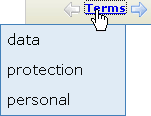
Your search terms are also shown at the top left of the Document screen:
![]()
The terms for which you searched on the Search screen are shown in red in the document:
![]()
Document Info panel
Just above the document, you can see the abbreviated name of the database to which the document belongs, and its position in the collection of results.

Click the abbreviation of the database to see its full name and copyright information, and a link to information about the coverage of the database.
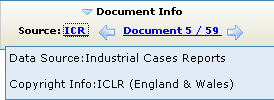
The “Document” link allows you to browse through the records found by the last query.
Click the blue left and right arrows to move from one document to the previous or next (a grey arrow means that there are no more documents). If you click the Document link itself, you can display a document by clicking its title in the list of results. If the list of documents is long, then you can see other parts of the list by entering the number of a document and clicking “Go”, or by clicking the “Current”, “First” or “Last” links.
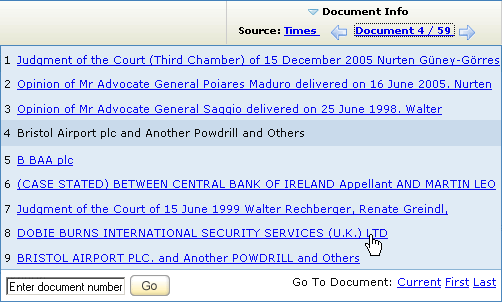
Linking to other documents
Hypertext links to other documents or to other pages in the current document are indicated by blue text (which becomes red and underlined when the mouse pointer is over it); click to jump to the other page or document:

If you see a publication reference for another document that you would like to see (and it is not a hypertext link), select it by dragging over the reference with your mouse, and then click “J-Link” in the Document Actions panel. Justis will attempt to find the document (using Justis Publishing’s J-Link technology), even if it is in a database that you have not selected. You will see an error message if you click “J-Link” without having selected a reference.
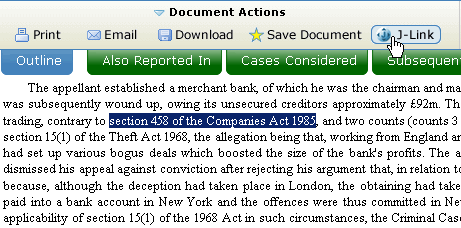
A panel opens containing one or more links to documents in Justis databases; click a link to view the full text of the document. If you subscribe to JustCite, the legal citator from Justis Publishing, then there will also be a link to the information about the current document in JustCite.

Some Web browsers, notably Safari, do not allow the “J-Link” button to work, so please use the alternative method of using J-Link.
Searching within a document
![]() If you are using Windows and you want to find a word or phrase with the document that you are viewing, then use the Control+F key combination to open the Find dialog box:
If you are using Windows and you want to find a word or phrase with the document that you are viewing, then use the Control+F key combination to open the Find dialog box:
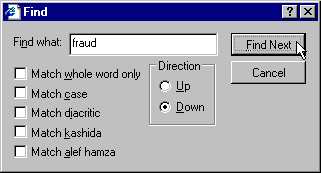
Type the word(s) you want to find, and then click the “Find Next” button.
![]() If you are using a Macintosh and you want to find a word or phrase with the document that you are viewing, then use the Command+F key combination to open the Find dialog box.
If you are using a Macintosh and you want to find a word or phrase with the document that you are viewing, then use the Command+F key combination to open the Find dialog box.
Document Actions panel

You can print, email, download or save a link to the document by clicking the “Print”, “Email”, “Download” or “Save Document” link in the Document Actions panel at the top left of the document. You can link to another document to which a reference is given by clicking “J-Link”.
PDF tab
Documents in several of the Justis databases can be viewed as PDF files, by clicking the red “PDF” tab. These PDF (portable document format) files provide an accurate representation of the original printed documents, such as papers from the Official Journal of the European Union and case reports from The Law Reports, The Weekly Law Reports, Industrial Cases Reports, English Reports and Session Cases.

Even though printouts from Justis databases are acceptable for use in courts in the United Kingdom, some people do prefer printouts that exactly reproduce the appearance of printed case reports, including side letters, and PDF files provide this.
In order to display a PDF file on your computer screen, you need the free Adobe Reader program (formerly known as Adobe Acrobat Reader). This is installed on many new computers, but if you do not have a copy, then you can download a copy from the Adobe website:
JustCite tabs
Many documents in Justis databases are related to earlier and later case law and statute law documents, and you can find lists of these documents by clicking one of the green tabs at the top of the document.
![]()
The information comes from JustCite, the on-line legal citator from Justis Publishing. JustCite is a subscription service, and so more information is available to subscribers.
In case law databases, cases referred to in the Headnote are used to produce lists of preceding and subsequent cases. In CELEX and in the legislation databases, there are similar lists of documents that amend or are amended by the current document.
- Abbreviations used on the Amendments and Amended By tabs
- Abbreviations used on the Cases Considered tab
![]()
document.html; last updated 4th October 2007
Copyright © 2006–2007 Justis Publishing Limited